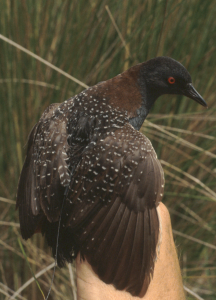
Black Rail is the smallest and rarest of the North American rails. Photo courtesy of Mike Legare/USFWS
The Black Rail is the smallest and rarest of the North American rails. This elusive species has a striking appearance with its dark body and bright red iris, and of the five subspecies of Black Rail, the Eastern Black Rail may be one of the most imperiled birds along the Atlantic and Gulf Coasts. Recent region-wide efforts indicate that Eastern Black Rail populations are declining, or are extirpated, in at least eight of the Atlantic and Gulf Coast states where they were once known to breed.
The reason for the dramatic decline of Black Rails is not completely understood but is likely a combination of habitat loss, sea level rise, and development in high marsh areas. Coastal marshes will be one of the first habitats consumed by rising seas because of their low elevation and location within the landscape. In some natural areas the salt marsh will have the ability to migrate upslope, but in many developed areas there are structural limitations that will prevent marsh migration.
Several states along the Atlantic and Gulf Coasts are putting forth effort to evaluate the population status and distribution of Black Rails. An Eastern Black Rail Working Group comprised of people from a wide range of agencies was created to focus research efforts and develop approaches for Black Rail conservation and a sustainable recovery for this species.
South Carolina is one of those states involved in Black Rail conservation efforts. Black Rail has been known to breed there since 1903, and is also considered a rare winter resident. During an extensive marsh bird survey conducted by the South Carolina Department of Natural Resources in the early 1990’s, biologists counted a total of 38 Black Rails. In 2014, when surveys were conducted again, Black Rail was detected in only three of the same areas where they had been previously detected, with low numbers found at three additional areas in the State. Over half of the detections occurred in large managed-wetland complexes on a single wildlife management area during both studies. Data collected so far indicate that Black Rail has persisted in low numbers at historic breeding areas in the state. Using the knowledge gained during the 1990’s and 2014 studies, a more targeted and intensive study will be conducted in 2015. “Much is still unknown about Black Rail behavior and habitat needs. We’re hoping to better understand Black Rail ecology to help with conservation for the species,” says Amy Tegeler, Bird Conservation Coordinator for the South Carolina Department of Natural Resources.
For more information on the Eastern Black Rail Working Group and Black Rail conservation visit: http://www.ccbbirds.org/what-we-do/research/species-of-concern/blackrail/working-group/. Additionally, A Griffin Group titled Black Rail Working Group has been established as a forum for information exchange on the Black Rail: https://griffingroups.com/groups/profile/209223/black-rail-working-group

